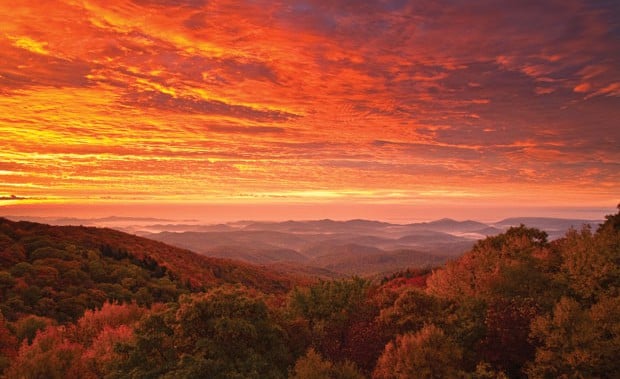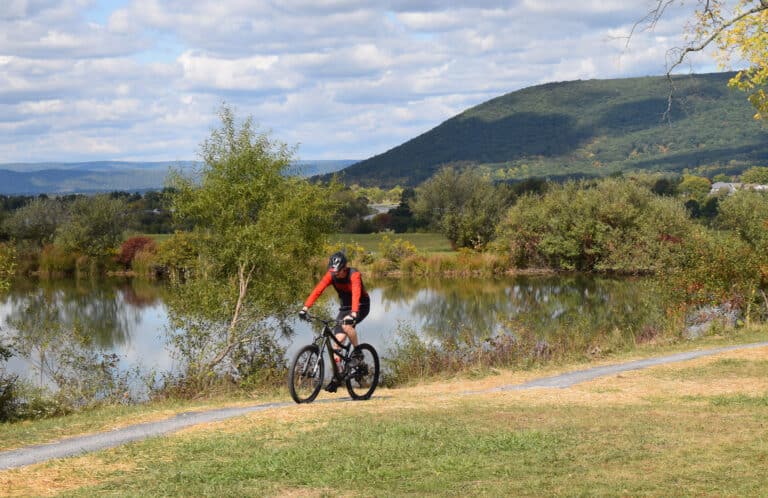Photo: Ashley Woodring
An exceptionally rugged mountain, Grandfather is home to some of the most biologically diverse wilderness in the Southeast. Its abundance of exposed crags, towering altitude, dense vegetation, and cool damp climate create a patchwork of distinct biospheres. Explorers named the mountain “Grandfather” after the old man’s face they saw in the cliffs.
After inheriting the mountain from his grandfather in 1952, Hugh Morton built the Mile High Bridge, completed the first road, and opened the Grandfather Mountain Attraction, laying the foundation for what would ultimately help protect the rare and diverse plant and animal life that Grandfather Mountain supports and nurtures. When Morton died, his family created the Stewardship Foundation and sold the backcountry to the state. Today, you can access 2,700 acres of wilderness through the newly formed state park, or drive to the peak and walk the Mile High Swinging Bridge, which is still privately owned.
Here are three ways to fall in love with Grandfather Mountain:
Walk the mile high swinging bridge
 Drive your car up Grandfather Mountain to walk the highest suspension footbridge in America. The Mile High Bridge connects two rocky summits at a mile above sea level. Originally wooden, it was replaced with a steel bridge in 1999.
Drive your car up Grandfather Mountain to walk the highest suspension footbridge in America. The Mile High Bridge connects two rocky summits at a mile above sea level. Originally wooden, it was replaced with a steel bridge in 1999.
“Crossing the bridge gives you that feeling of being on top of the world,” says Landis Wofford, director of communications for the Grandfather Mountain Stewardship Foundation. “Once you cross over to Linville Peak, you can look down, and on a clear day see the skyline of Charlotte, about 80 miles away as the crow flies.”
Feel the rush of the strong winds that have permanently wind-dwarfed the spruce and fir trees at the summit. The sonic anemometer on the bridge has recorded gusts as high as 114.7 mph, one of the highest speeds ever recorded in North Carolina. Bring your own food or order to go at Mildred’s Grill, and set up a picnic at any of the 100 picnic tables throughout the mountain. Meander down nature trails or navigate craggy terrain with the help of cables and ladders. Entrance to the foundation-owned part of the mountain, which includes the mile-high swinging bridge, costs $18 for adults, $8 for children. Entrance to the adjacent state park is free.
Hike the profile trail and camp
Park your car at the Profile Trailhead, off of NC 105, where you’ll self-register from the permit box. The Profile Trail is just under 3 miles, but the rare and diverse plant and animal life you’ll experience as you snake up the mountain will transport you to other worlds. You’ll cross the Watauga River, weave through rhododendron thickets and lush ferns, and under a dense hardwood canopy. As you wind up the Profile Trail, you’ll move through several of the Grandfather’s 16 distinct natural communities, glimpsing many of the park’s 72 known species of rare and endangered plants and animals.
“In the springtime, the wildflowers are phenomenal,” says Sue McBean, Grandfather Mountain State Park Superintendent. “Early in the season, watch for several species of violets that bloom one after another.” As spring unfolds, look for the exquisite Pink Lady Slipper and Painted Trillium dotting the trail. Set up camp at the site two miles up the Profile Trail, and settle into the peace that only the backcountry can offer.
If you’re up for a strenuous climb, continue up the steep, rocky segment to the Grandfather Trail, where you’ll be rewarded with sweeping views as you walk along the ridge line. The park has a total of 13 campsites, all of which are first come, first serve.
Road cycle the Linn Cove Viaduct
At 4,100 feet above sea level, the Linn Cove Viaduct skirts the edges of Grandfather Mountain, offering bird’s-eye views of the Blue Ridge. In order to protect the delicate balance of the ecological communities of Grandfather Mountain, engineers worked with the National Park Service to design what has been called the most complicated concrete bridge ever built. This quarter mile, serpentine bridge was the last piece of the Parkway to be completed. Shaw Brown, one of the owners of Boone Bikes, recommends treating yourself to the magnificent views with your road bike.
Start by parking at the Julian Price Memorial Park, a few miles north of the Viaduct. Head south on the Parkway to climb up Grandfather, roll over the viaduct, and a mile or two south of it, intersect with 221, where you’ll head north, backtracking toward Price Park. Continue on 221 until you intersect with Holloway Mountain Road. This will bring you back to the Parkway, where you’ll continue north to get back to Julian Price Park.
“Considering the short length of the ride,” says Brown, “it’s one of the most scenic routes in the area. You’ve got these great long-range views from up there.” Brown recommends checking the weather and making sure you have the right gear before heading up, since it can be at least 10 degrees cooler at those elevations.








